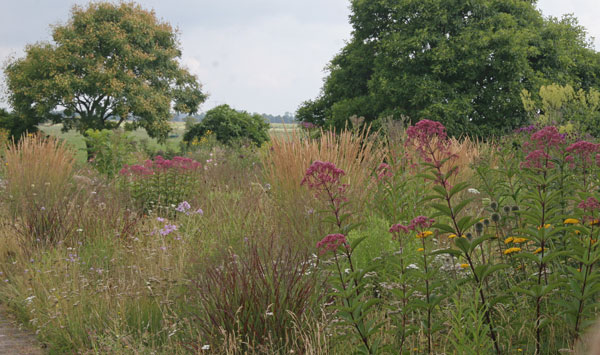John Hoffman’s Three Favorites at Appeltern Gardens
John Hoffman found art and plenty of ornamental grasses throughout the 56 acres of Appeltern Garden in The Netherlands. Find out the three aspects of the garden he loved the best.
Read Post
Piet Oudolf knows grasses. His planting designs in Europe and the United States are masterful mixes of textures, colors, and seasonal highlights. He consulted on planting designs for the Lurie Garden in Chicago’s Millennium Park and the High Line in New York, both of which use a matrix of grasses to support a wide range of perennials. Piet’s knowledge and experience with grasses make his gardens a must-see for grass lovers.
Piet’s home garden in the Netherlands illustrates the integral role that grasses play in his designs. This August, John and Jill Hoffman, along with their son, David, visited the Oudolf garden. Henk de Jong of CNB New Plants arranged the visit, and went with them to the garden. The group spent time meandering and talking with Piet. Which grasses caught their eye?
1. Calamagrostis x acutiflora ‘Karl Foerster’ (Feather Reed Grass)
The large, open areas of the garden are punctuated by plantings of Feather Reed Grass and Joe Pye Weed. The plumes of this popular, cool season grass appear in spring and persist well into the fall. ‘Karl Foerster’ has an architecture that Oudolf refers to as “emergent.” Most of their foliage is concentrated at the base, while the blooms are on upright stems above the foliage. ‘Karl Foerster’, like other emergents, stand tall and look good above shorter plants. They are seen separately from their surroundings and are useful for creating structure and emphasis.

2. Nassella tenuissima (Mexican Feather Grass)
The ultra-fine foliage of Mexican Feather Grass catches the tiniest hint of a breeze and comes alive with motion. The flowing habit has a softness and texture that is both visual and tactile. It appears extensively throughout the site, softening hardscape and keeping the garden in motion. Piet notes that serendipity should be allowed to play a role in a garden, and the reseeding of Mexican Feather Grass adds that element of chance. Nassella tenuissima also serves as part of the garden matrix, a layer of plants that anchor the plant combinations and support the more showy perennials.

3. Deschampsia cespitosa ‘Goldtau’ (Golden Dew Tufted Hair Grass)
‘Goldtau’ is a compact cultivar of Tufted Hair Grass. The plumes are bright chartreuse-yellow, aging to bronze. Here in the garden, the airy plumes and foliage provide a base for showy, flowering perennials. It’s part of the matrix that Oudolf establishes in his plantings. He often pairs the wispy plumes with hard, dark, defined shapes to lend interest to the fall and winter garden.

4. Panicum virgatum ‘Shenandoah’ (Red Switchgrass)

Piet calls ‘Shenandoah’, “...structural, but at the same time, low-key.” In his garden, the red and burgundy highlights create depth and contrast. On the High Line in New York, Panicum ‘Shenandoah’ serves as a matrix plant, with blocks of other grasses scattered throughout. Red Switchgrass provides interest from mid-summer on through the winter months.
5. Sporobolus heterolepis ‘Tara’ (Dwarf Prairie Dropseed)
Prairie Dropseed is an elegant grass with wonderful habit and texture. ‘Tara’ takes its best qualities, shrinks them down, and adds some uniformity. Large sweeps of ‘Tara’ are amazingly beautiful, with showy plumes and a uniform habit. It’s sprinkled liberally throughout the Oudolf garden, serving as a matrix plant with its neat habit and airy, see-through plumage.

Spending time with Piet was especially fun for John Hoffman. John’s travels through Europe early in his career, including visits with Piet , shaped his love for grasses. John was happy to see many Hoffman Nursery favorites among the garden plants. So take a page from Piet Oudolf’s design book, and try these great grasses for yourself!

Get Current Availability: Excel Download |PDF Download